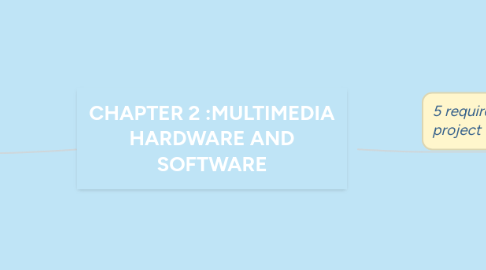
1. 4 stage in a multimedia project
1.1. 1.planning & costing
1.1.1. Define the objective and scope
1.1.2. Target user
1.1.3. Set the contents
1.1.4. Prepare time estimate and a budget
1.1.5. Prepare a short prototype or proof-of-concept
1.2. 2.Designing & producing
1.2.1. Perform each of the planned tasks to create a finished product
1.3. 3.Testing
1.3.1. Test your programs to make sure that they meet the objective of your project
1.3.2. 2 phases of testing
1.3.2.1. Alpha Testing
1.3.2.1.1. to review the concept ,format,user interface and the layout
1.3.2.2. Beta Testing
1.3.2.2.1. to find bugs or content errors
1.4. 4.delivering
1.4.1. package and deliver the project to the end user
2. 5 requirements of for a multimedia project
2.1. 1.The intangibles
2.1.1. Creativity
2.1.1.1. Creative implies knowledge of hardware and software
2.1.2. Organization
2.1.2.1. To develop an organized outline detailing the skills,time,budget,tools, and resources needed for the project.
2.1.3. Communication
2.1.3.1. Communication among the workgroup and client is essential to the efficient and accurate completion of your project.
2.2. 2.Multimedia skills
2.2.1. 6 main roles in the term
2.2.1.1. 1. Project Manager
2.2.1.1.1. The leader of project
2.2.1.2. 2.Multimedia Designer
2.2.1.2.1. Determines the design elements required to support that structure
2.2.1.3. 3.Interface Designer
2.2.1.3.1. In charge of designing each screen or page interface that lets the user access or modify the content-simplicity
2.2.1.4. 4.Writer
2.2.1.4.1. write text screen to deliver message
2.2.1.5. 5.Video/Audio Specialist
2.2.1.5.1. Focus on the audio and video production
2.2.1.6. 6.Multimedia Programmers
2.2.1.6.1. integrate all the elements of the project using an authoring system or programming language
2.3. 3.Hardware
2.3.1. Production Platforms
2.3.1.1. The Macintosh and Windows PC offer a combination of affordability and software and hardware availability.
2.3.2. Window vs Macintosh
2.3.3. 3 Type of Connections
2.3.3.1. 1.Integrated Drive Electronic (IDE)
2.3.3.1.1. Standard interface for connecting a motherboard to to storage device such as hard drives and CD-ROM/DVD drives.
2.3.3.2. 2.Universal Serial Bus(USB)
2.3.3.2.1. Plug-and-play interface (without reconfiguration or adjustment by the user)
2.3.3.3. 3.FireWira
2.3.3.3.1. For connecting devices to personal computer
2.3.4. Memory & Storage devices
2.3.4.1. Memory requirements of a multimedia project depend on the project's content and scope
2.3.4.2. 2 Type of Memory
2.3.4.2.1. Random Access Memory(RAM)
2.3.4.2.2. Read-Only Memory(ROM)
2.3.4.3. Hard disks
2.3.4.3.1. Nonvolatile storage
2.3.4.3.2. Have a high data storage capacity and data transfer speed..
2.3.4.4. Flash or thumb drives
2.3.4.5. CD-ROM
2.3.4.6. DVD
2.3.4.7. Blu-ray discs
2.3.5. Input Devices
2.3.5.1. Voice recognition system recognize spoken words and commands EXAMPLE: Microphones , Digital Cameras
2.3.6. Output Devices
2.3.6.1. Stereo
2.3.6.2. Monitor
2.3.6.3. Projector
2.3.6.4. Printer
2.4. 4.Software
2.4.1. Text editing and word processing tools
2.4.1.1. Microsoft Word and Word Prefect
2.4.2. OCR software
2.4.2.1. make use of probability and expert system algorithms
2.4.3. Painting tools allow you yo create and modify bitmap images.
2.4.3.1. Photoshop,Fireworks,and Painter
2.4.4. Drawing tools allow you to create and modify vector graphics
2.4.4.1. CorelDraw,Illustrator,and Canvas
2.4.5. Painting and Drawing Software Feature
2.4.5.1. Scalable dimensions
2.4.5.2. Multiple undo capability
2.4.5.3. Layering capability
2.4.6. 3-D modeling tools allow rendering of objects in a three-dimensional perspective
2.4.6.1. VectorWorks,AutoDesk Maya,Strata 3D
2.4.7. Image editing tools
2.4.7.1. Powerful tools for enhancing retouching, blurring, sharpening, lightening existing bitmapped images
2.4.8. Sound editing tools
2.4.8.1. cut,copy,paste,and edit certain segments of the music
2.4.9. animation,video,and digital movie tools
2.5. 5.Authoring system
2.5.1. An authoring tools is a software package which allow developers to:
2.5.1.1. create interactivity
2.5.1.2. Design screen layouts(interface) using templates
2.5.2. 3 Type of authoring tools
2.5.2.1. card-and page-based authoring tools
2.5.2.1.1. elements are arranged like page of a book or card in a stack
2.5.2.2. Icon-and object-based authoring tools
2.5.2.2.1. multimedia elements and interaction cues are organized as objects in a flow chart
2.5.2.3. time-based authoring tools
2.5.2.3.1. the elements of the program are organized along a time line
2.5.3. objects
2.5.3.1. objects may contain scripts that specify a related action
2.5.4. Choosing an Authoring tool
2.5.4.1. Editing and organizing deatures
2.5.4.1.1. editing tools to create , edit , and convert multimedia elements such as animation and video
2.5.4.2. Programming features
2.5.4.2.1. visual programming with icons or objects is the simplest and easiest authoring process
2.5.4.3. Interactivity features
2.5.4.3.1. gives the end user control over the content and flow of information in a project
2.5.4.4. Performance-tuning
2.5.4.4.1. achieving synchronization is difficult,authoring system should facilitate precise timing of events.
2.5.4.5. playback features
2.5.4.5.1. enable developers to build part of a project and then test it immediately
2.5.4.6. delivery features
2.5.4.6.1. a run-time or stand-alone version allows a project to be executed without authoring software
2.5.4.7. cross-platform
2.5.4.7.1. it is important to use tools that facilitate easy transfer across platforms EXAMPLE: Macintosh to Window
2.5.4.8. Internet-playability features
2.5.4.8.1. authoring system provide a means for converting their output to be delivered within the context of HTML or DHTML.
2.5.4.9. Programming features

